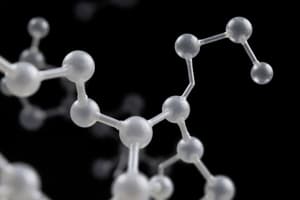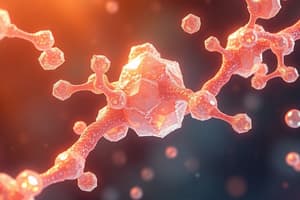Podcast
Questions and Answers
What type of glucose is mentioned in the content?
What type of glucose is mentioned in the content?
- Non-sweetly fermentable (correct)
- Completely fermentable
- Sweetly fermentable
- Partially fermentable
What effect does the content suggest glucose has on babies?
What effect does the content suggest glucose has on babies?
- Prevents fermentable production (correct)
- Enhances sweetness in diet
- Enables fermentable production
- Increases fermentable capacity
Which statement best describes the glucose mentioned in the content?
Which statement best describes the glucose mentioned in the content?
- It is a single type found in all foods.
- It combines various types of fermentable sugars.
- It is specifically non-fermentable. (correct)
- It can be both sweet and fermentable.
What is the primary characteristic of the glucose referred to in the content?
What is the primary characteristic of the glucose referred to in the content?
In the context provided, what is not indicated about the glucose?
In the context provided, what is not indicated about the glucose?
What is a monosaccharide?
What is a monosaccharide?
Which type of carbohydrate yields between 2 to 10 monosaccharide units?
Which type of carbohydrate yields between 2 to 10 monosaccharide units?
What distinguishes a polysaccharide from other carbohydrates?
What distinguishes a polysaccharide from other carbohydrates?
Which statement is true regarding oligosaccharides?
Which statement is true regarding oligosaccharides?
Which of the following carbohydrates cannot be hydrolyzed any further?
Which of the following carbohydrates cannot be hydrolyzed any further?
What is the first step in the digestion of carbohydrates?
What is the first step in the digestion of carbohydrates?
Which enzyme is responsible for initiating the carbohydrate digestion process in the mouth?
Which enzyme is responsible for initiating the carbohydrate digestion process in the mouth?
What is the primary function of carbohydrate digestion?
What is the primary function of carbohydrate digestion?
What are the end products of carbohydrate digestion?
What are the end products of carbohydrate digestion?
Which of the following best describes the initial breakdown of starch during digestion?
Which of the following best describes the initial breakdown of starch during digestion?
What happens when glycogen stores are depleted?
What happens when glycogen stores are depleted?
What is the normal range for blood glucose levels in a healthy individual after an overnight fast?
What is the normal range for blood glucose levels in a healthy individual after an overnight fast?
How does insulin function in the regulation of blood glucose levels?
How does insulin function in the regulation of blood glucose levels?
Which cells of the pancreas are responsible for secreting insulin?
Which cells of the pancreas are responsible for secreting insulin?
Which of the following statements is incorrect regarding blood glucose regulation?
Which of the following statements is incorrect regarding blood glucose regulation?
What is the primary function of glucagon in the body?
What is the primary function of glucagon in the body?
Which type of cells in the pancreas secrete glucagon?
Which type of cells in the pancreas secrete glucagon?
How does epinephrine affect glucose levels during stress?
How does epinephrine affect glucose levels during stress?
In what circumstances is glucagon primarily utilized?
In what circumstances is glucagon primarily utilized?
What distinguishes glucagon's role from that of epinephrine?
What distinguishes glucagon's role from that of epinephrine?
What fasting blood glucose level is associated with hypoglycemia?
What fasting blood glucose level is associated with hypoglycemia?
What is the minimum fasting blood glucose level to be considered normal?
What is the minimum fasting blood glucose level to be considered normal?
Which dietary change is suggested to help manage hypoglycemia?
Which dietary change is suggested to help manage hypoglycemia?
What condition might arise if dietary changes are not made in response to abnormal fasting blood glucose levels?
What condition might arise if dietary changes are not made in response to abnormal fasting blood glucose levels?
Which statement is most accurate regarding the relationship between fasting blood glucose levels and hypoglycemia?
Which statement is most accurate regarding the relationship between fasting blood glucose levels and hypoglycemia?
Flashcards
Monosaccharide
Monosaccharide
The simplest form of carbohydrate that cannot be broken down further by hydrolysis.
Oligosaccharide
Oligosaccharide
A carbohydrate composed of 2 to 10 monosaccharide units.
Polysaccharide
Polysaccharide
A carbohydrate made of more than 10 monosaccharide units.
Hydrolysis
Hydrolysis
Signup and view all the flashcards
Carbohydrate
Carbohydrate
Signup and view all the flashcards
Glucose type
Glucose type
Signup and view all the flashcards
Non-fermentable sugar
Non-fermentable sugar
Signup and view all the flashcards
Fermentation's impact
Fermentation's impact
Signup and view all the flashcards
Baby's digestion
Baby's digestion
Signup and view all the flashcards
Sugar composition
Sugar composition
Signup and view all the flashcards
Where does starch digestion begin?
Where does starch digestion begin?
Signup and view all the flashcards
What does salivary amylase break down?
What does salivary amylase break down?
Signup and view all the flashcards
Dextrin
Dextrin
Signup and view all the flashcards
Maltose
Maltose
Signup and view all the flashcards
What is the final product of carbohydrate digestion?
What is the final product of carbohydrate digestion?
Signup and view all the flashcards
Glucagon
Glucagon
Signup and view all the flashcards
Epinephrine's role
Epinephrine's role
Signup and view all the flashcards
What is the main function of glucagon?
What is the main function of glucagon?
Signup and view all the flashcards
When is epinephrine secreted?
When is epinephrine secreted?
Signup and view all the flashcards
How do glucagon and epinephrine differ?
How do glucagon and epinephrine differ?
Signup and view all the flashcards
Glycogen depletion
Glycogen depletion
Signup and view all the flashcards
Normal blood glucose
Normal blood glucose
Signup and view all the flashcards
Insulin's role
Insulin's role
Signup and view all the flashcards
Blood sugar regulation?
Blood sugar regulation?
Signup and view all the flashcards
What do β cells do?
What do β cells do?
Signup and view all the flashcards
Hypoglycemia
Hypoglycemia
Signup and view all the flashcards
Fasting Blood Glucose
Fasting Blood Glucose
Signup and view all the flashcards
Controlled by Dietary Changes
Controlled by Dietary Changes
Signup and view all the flashcards
126mg/dl
126mg/dl
Signup and view all the flashcards
Fasting Blood Glucose Level
Fasting Blood Glucose Level
Signup and view all the flashcards
Study Notes
Carbohydrate Chemistry
- Carbohydrates are organic compounds made of C, H, and O.
- They generally have the formula (CH₂O)n, where the least number of n is 3.
- Carbohydrates are polyhydroxy-ketones or polyhydroxy-aldehydes.
Importance of Carbohydrates
- Main energy source
- Structural components in cell membranes
- Lubrication of joints and tendons (Proteoglycans)
Importance of CHO
- Pentose sugars are part of nucleotides, forming nucleic acids (DNA, RNA), coenzymes (NAD, FAD), regulatory molecules (cAMP, cGMP), and high-energy compounds (ATP, GTP).
Classification of Carbohydrates
- Classified according to the number of sugar units yielded on hydrolysis:
- Monosaccharides: The simplest form, cannot be hydrolyzed further.
- Oligosaccharides: Yields 2-10 monosaccharide units on hydrolysis.
- Polysaccharides: Yields more than 10 monosaccharide units on hydrolysis.
Classification of Monosaccharides
- Classified by number of carbon atoms and active groups:
- Trioses (3C): Aldo triose (e.g., glyceraldehyde), Keto triose (e.g., dihydroxyacetone)
- Tetroses (4C): Aldo tetrose (e.g., erythrose), Keto tetrose (e.g., erythrulose)
- Pentoses (5C): Aldo pentose (e.g., ribose), Keto pentose (e.g., ribulose)
- Hexoses (6C): Aldo hexose (e.g., glucose, galactose), Keto hexose (e.g., fructose)
- Specific examples of monosaccharides:
- Glucose: Essential energy source, blood sugar
- Fructose: Sweetest, naturally in honey and fruits
- Galactose: Rarely occurs as a single sugar
Oligosaccharides (Disaccharides)
- Type of carbohydrates formed of 2-10 monosaccharide units linked by glycosidic bonds.
- Examples:
- Maltose: Malt sugar, formed of 2 glucose units
- Sucrose: Cane sugar, formed of one glucose and one fructose unit
- Lactose: Milk sugar, formed of one glucose and one galactose unit
Polysaccharides
-
Classified as homogenous or heterogeneous.
-
Homogenous Polysaccharides:
- Starch: Major storage carbohydrate in plants, formed of amylose (long straight chains) and amylopectin (branched chains). Provides 80% of dietary calories globally.
- Glycogen: Major storage carbohydrate in animals, mainly stored in liver and skeletal muscles. Highly branched structure for rapid glucose release (e.g., during exercise).
- Cellulose: Major plant cell wall component; composed of long linear chains of glucose; non-digestible, increases stool bulk, prevents constipation.
- Dextrin
-
Heterogeneous Polysaccharides:
- Glycolipids
- Glycoproteins
Digestion and Absorption of Carbohydrates
- Digestion breaks down large molecules into their simplest form (monosaccharides).
- Mouth: Salivary amylase hydrolyzes starch into dextrins and maltose.
- Stomach: Amylase action stops due to low pH.
- Small Intestine: Pancreatic amylase converts starch and glycogen to disaccharides and monosaccharides. Disaccharidases (sucrase, lactase, maltase) further break down disaccharides to monosaccharides (glucose, fructose, and galactose).
- Absorption: Monosaccharides are absorbed into the bloodstream via glucose transporters (SGLT and GLUT).
- Large Intestine: Fibers attract water, soften stools, and ferment.
- Products of digestion: glucose, fructose, and galactose
Glucose in the Body
- Body stores glucose as glycogen in liver and muscle cells.
- Glucose is used for energy if glycogen is available.
- If glycogen stores are depleted, the body produces glucose from other sources.
- Blood glucose levels in healthy individuals after an overnight fast range from 70-100 mg/dL.
Regulation of Blood Glucose
- Insulin: Secreted by beta cells of the pancreas, moves glucose into cells, lowers blood sugar.
- Glucagon: Secreted by alpha cells of the pancreas, brings glucose out of storage, raises blood sugar.
- Epinephrine: Acts quickly to bring glucose out of storage during times of stress.
Abnormal Blood Glucose
- Hyperglycemia: High blood glucose, often associated with type 1 and type 2 diabetes.
- Type 1 Diabetes: Insulin deficiency; Less common
- Type 2 Diabetes: Insulin resistance; More common.
- Prediabetes: Higher-than-normal but not diagnostic of diabetes fasting blood glucose level from 100 to 125 mg/dL
Lactose Intolerance
- Inability to digest lactose (milk sugar)
- Symptoms include bloating, abdominal discomfort, and diarrhea.
- Causes: Lactase deficiency (natural decrease or damage to intestinal cells).
Lactose Intolerance Management
- Dietary changes: lactose-free diet initially, gradually increasing milk products, spreading dairy intake, using fermented dairy products (e.g., yogurt, acidophilus milk), using Lactase enzymes.
Recommended Intake of CHO
- RDA for carbohydrates is 130 g per day, or 45-65% of energy intake.
Artificial Sweetners
- Saccharin: Primarily for soft drinks and tabletop use.
- Aspartame: General purpose sweetener.
Studying That Suits You
Use AI to generate personalized quizzes and flashcards to suit your learning preferences.




